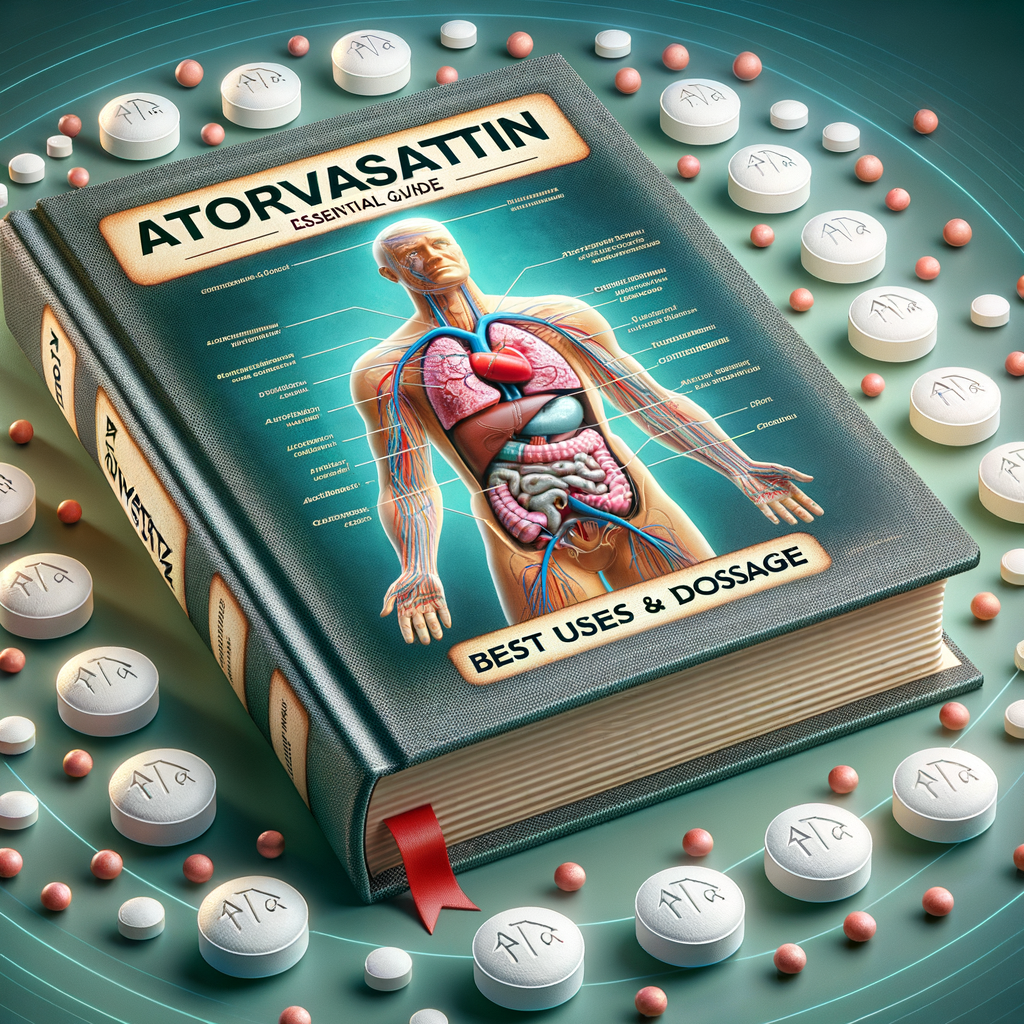
- Introduction
- What Is Atorvastatin?
- Primary Uses of Atorvastatin
- Secondary Prevention and Post-Event Use
- Familial Hypercholesterolemia and Genetic Conditions
- How Atorvastatin Works
- Effect on Other Lipids
- Common Atorvastatin Dosages
- Typical Starting Doses
- Table: Atorvastatin Intensity and Typical LDL Reduction
- How to Take Atorvastatin
- Special Administration Tips
- Dosage Adjustments and Special Populations
- Renal Impairment
- Pregnancy, Breastfeeding, and Pediatrics
- Drug Interactions and Contraindications
- Contraindications
- Side Effects and Safety
- Monitoring While on Therapy
- Managing Side Effects
- Addressing Liver Concerns
- Combining Atorvastatin with Other Lipid-Lowering Drugs
- Common Combination Strategies
- Lifestyle Changes to Complement Atorvastatin
- Dietary Tips
- Practical Tips for Adherence
- Cost and Access
- When to Contact Your Healthcare Provider
- Summary and Key Takeaways
- Frequently Asked Questions (FAQs)
- 1. How long does it take for atorvastatin to lower cholesterol?
- 2. Can I drink alcohol while taking atorvastatin?
- 3. Is atorvastatin safe for older adults?
- 4. What should I do if I miss a dose?
- 5. Can atorvastatin cause memory problems?
- 6. Are there foods I should avoid while on atorvastatin?
- 7. Can I stop atorvastatin once my cholesterol improves?
- 8. What tests will my doctor run while I’m on atorvastatin?
- 9. Can atorvastatin interact with over-the-counter supplements?
- 10. What are alternatives if I cannot tolerate atorvastatin?
- References
Introduction
Atorvastatin stands among the most prescribed cholesterol medicines worldwide. People take it to reduce LDL cholesterol, lower heart attack risk, and improve overall cardiovascular health. In this article, I explain atorvastatin uses and dosage in clear, practical terms.
You will find guidance on how it works, when doctors prescribe it, and how to take it safely. Additionally, I cover common side effects, monitoring, interactions, and special situations. Finally, I answer frequently asked questions that often follow a prescription.
What Is Atorvastatin?
Atorvastatin belongs to the statin drug class. Statins reduce cholesterol production in the liver by blocking the HMG-CoA reductase enzyme. As a result, the liver removes more LDL cholesterol from the blood.
Doctors prescribe atorvastatin for high cholesterol and to prevent cardiovascular events. It comes in tablet form and in several strengths. Moreover, it has a well-studied safety and efficacy profile.
Primary Uses of Atorvastatin
Atorvastatin primarily lowers low-density lipoprotein (LDL) cholesterol. Lowering LDL reduces the chance of atherosclerotic plaque buildup in arteries. Consequently, it decreases the long-term risk of heart attacks and strokes.
In addition, doctors use atorvastatin for primary prevention in people with risk factors. These include diabetes, high blood pressure, smoking, and family history of heart disease. Furthermore, clinicians tailor treatment to each patient’s overall risk profile.
Secondary Prevention and Post-Event Use
After a heart attack or stroke, physicians prescribe atorvastatin to prevent recurrence. Evidence shows statins reduce mortality and subsequent cardiovascular events. Thus, patients often continue therapy long-term.
Moreover, atorvastatin improves outcomes after procedures. For example, doctors use it to lower risk after coronary artery stenting. In such cases, starting statin therapy early provides added benefits.
Familial Hypercholesterolemia and Genetic Conditions
People with familial hypercholesterolemia (FH) often need high-intensity statin therapy. Atorvastatin can significantly reduce LDL in these patients. However, clinicians frequently combine it with other lipid-lowering drugs for optimal control.
Genetic testing and specialist referral help guide treatment choices. Consequently, patients with FH benefit from a tailored, aggressive approach to lower lifetime cardiovascular risk.
How Atorvastatin Works
Atorvastatin inhibits the HMG-CoA reductase enzyme in the liver. This enzyme plays a key role in cholesterol synthesis. When the enzyme blocks, liver cholesterol production falls.
As a result, the liver increases LDL receptor activity. The liver then clears more LDL from the bloodstream. Therefore, blood LDL levels drop, and cardiovascular risk decreases.
Effect on Other Lipids
Atorvastatin reduces triglycerides and raises HDL cholesterol to some extent. However, its main benefit remains LDL reduction. For severe triglyceride problems, clinicians may add other drugs.
Besides lipid effects, statins possess anti-inflammatory properties. These benefits may stabilize atherosclerotic plaques. Consequently, statins lower the risk of plaque rupture and clot formation.
Common Atorvastatin Dosages
Clinicians prescribe atorvastatin in several doses. Available tablet strengths typically include 10 mg, 20 mg, 40 mg, and 80 mg. Doctors choose doses based on treatment goals and patient risk.
Usually, clinicians start with a low or moderate dose. They then check cholesterol and adjust the dose. For high-risk patients, physicians often begin with higher doses for quicker LDL control.
Typical Starting Doses
- Adults without high cardiovascular risk: start 10–20 mg daily.
- Adults with high cardiovascular risk: start 40–80 mg daily.
- Patients with very high LDL (e.g., familial hypercholesterolemia): start 40–80 mg and consider combination therapy.
Physicians may adjust doses every 4–12 weeks depending on results. Frequent monitoring helps find the lowest effective dose.
Table: Atorvastatin Intensity and Typical LDL Reduction
| Intensity | Typical Dose | Approximate LDL Reduction |
|---|---|---|
| Low | 10 mg | 30% or less |
| Moderate | 10–20 mg | 30–50% |
| High | 40–80 mg | ≥50% |
Note: Individual responses vary. Doctors base therapy on lab results and risk calculations.
How to Take Atorvastatin
Take atorvastatin once daily at roughly the same time each day. You can take it with or without food. Consistency supports stable blood levels and better results.
If you miss a dose, take it as soon as you remember. However, skip the dose if the next dose is near. Never double up to make up a missed dose.
Special Administration Tips
- Swallow tablets whole with water.
- Do not crush or chew extended-release forms if prescribed.
- Keep the medication in its original container.
- Store at room temperature away from moisture and direct sunlight.
Additionally, inform your doctor about all medicines and supplements you use. Some drugs interact with atorvastatin and alter its effects.
Dosage Adjustments and Special Populations
Doctors adjust atorvastatin dosing for older adults and people with certain health issues. Age alone does not always require dose changes. However, older adults may face increased side-effect risk. Therefore, clinicians may start low and monitor closely.
People with liver disease require special attention. Atorvastatin undergoes hepatic metabolism. Consequently, moderate-to-severe liver impairment often precludes high doses. In such cases, doctors may choose alternatives.
Renal Impairment
Renal impairment rarely requires major dose changes for atorvastatin. The drug clears primarily through the liver. Nevertheless, severe kidney disease can change drug effects. Doctors will monitor kidney function and safety labs.
Additionally, dialysis does not remove atorvastatin effectively. Therefore, timing doses around dialysis sessions usually isn’t necessary.
Pregnancy, Breastfeeding, and Pediatrics
Do not use atorvastatin during pregnancy. Statins may harm fetal development. Women of childbearing potential should use contraception while on atorvastatin.
Avoid atorvastatin during breastfeeding. The drug can pass into breast milk and affect the infant. For pediatric patients, clinicians weigh benefits against risks. Some children with familial hypercholesterolemia may receive atorvastatin under specialist care.
Drug Interactions and Contraindications
Atorvastatin interacts with several medicines. Some drugs raise atorvastatin blood levels and increase side-effect risk. Others reduce its effectiveness. Therefore, tell your doctor about all medications, supplements, and herbal products.
Common interacting drugs include certain antibiotics, antifungals, HIV protease inhibitors, and some heart medications. Grapefruit juice also raises atorvastatin levels. Thus, avoid large amounts of grapefruit while taking this drug.
Contraindications
Do not use atorvastatin if you have active liver disease. Also avoid it during pregnancy and breastfeeding. People with previous serious allergic reactions to atorvastatin should not take it.
Additionally, combining atorvastatin with certain strong CYP3A4 inhibitors may be unsafe. Your clinician will check for such interactions and choose alternatives when needed.
Side Effects and Safety
Most people tolerate atorvastatin well. However, side effects can occur. Common issues include muscle aches, headache, and digestive changes. These symptoms often resolve over time.
A small percentage of patients develop more serious problems. These include liver enzyme elevations and rare muscle breakdown (rhabdomyolysis). Doctors monitor for these issues and act quickly if they appear.
Monitoring While on Therapy
Clinicians check liver enzymes before starting therapy. They repeat tests if symptoms suggest liver problems. Routine periodic testing may occur based on clinical judgment.
Besides liver tests, doctors measure lipid panels to track effectiveness. They typically recheck cholesterol 4–12 weeks after a dose change. After achieving goals, monitoring occurs every 3–12 months.
Managing Side Effects
If you develop mild muscle aches, report them to your clinician. They may lower the dose or switch drugs. In many cases, symptoms improve after dose adjustments.
For significant muscle pain, weakness, or dark urine, seek medical attention promptly. Such symptoms can signal severe muscle injury. Doctors will stop the medication and run tests if needed.
Addressing Liver Concerns
Report symptoms like unusual fatigue, yellowing of the skin, or dark urine. These could indicate liver injury. Clinicians will check liver enzyme levels and may stop the drug temporarily.
Do not self-stop therapy without consulting your healthcare provider. Abruptly stopping statins may increase short-term cardiovascular risk in some patients. Instead, discuss alternative options or dose changes.
Combining Atorvastatin with Other Lipid-Lowering Drugs
Sometimes, atorvastatin alone does not reach cholesterol targets. Doctors then add other agents to improve results. Combinations often include ezetimibe, bile acid sequestrants, or PCSK9 inhibitors.
Each additional drug brings distinct benefits and risks. For example, ezetimibe reduces LDL by blocking intestinal cholesterol absorption. PCSK9 inhibitors provide large LDL reductions for high-risk patients.
Common Combination Strategies
- Atorvastatin + ezetimibe: increases LDL reduction.
- Atorvastatin + bile acid sequestrants: useful if statin dose limits tolerance.
- Atorvastatin + PCSK9 inhibitor: for very high-risk or familial cases.
Doctors balance effectiveness, cost, and side effects when choosing combinations. Insurance coverage may influence available options.
Lifestyle Changes to Complement Atorvastatin
Medication works best with healthy habits. You should follow a heart-healthy diet and exercise regularly. These changes help lower LDL and support medication effects.
Stop smoking and limit alcohol intake. Additionally, maintain a healthy weight. Together, lifestyle changes and atorvastatin reduce cardiovascular risk more than either alone.
Dietary Tips
- Choose whole grains, fruits, and vegetables.
- Prefer lean proteins like fish and legumes.
- Use healthy fats such as olive oil and avocados.
- Limit saturated and trans fats.
Moreover, soluble fiber and plant sterols help lower LDL. Consider discussing a diet plan with a registered dietitian.
Practical Tips for Adherence
Take atorvastatin at the same time every day to build routine. Use pillboxes or phone reminders if needed. These small steps improve long-term adherence.
Discuss side effects early with your doctor. Often, adjusting timing, dose, or the drug itself resolves issues. Remember, lowering LDL is a long-term process.
Cost and Access
Atorvastatin exists in generic form and is usually affordable. Many insurance plans cover generic statins. Additionally, pharmacies and discount programs often lower out-of-pocket costs.
If cost becomes a barrier, ask your provider about alternatives or patient assistance programs. They can help you find an affordable, effective option.
When to Contact Your Healthcare Provider
Call your provider for new or worsening muscle pain, weakness, or dark urine. Also report yellowing of the skin, persistent abdominal pain, or unusual fatigue. These symptoms may indicate serious side effects.
Contact your clinician if you miss multiple doses or stop therapy. Stopping statins suddenly can increase cardiovascular risk. Your provider will guide safe ways to resume treatment or switch alternatives.
Summary and Key Takeaways
Atorvastatin reduces LDL cholesterol and lowers heart attack and stroke risk. Doctors prescribe it for primary and secondary prevention. Typical doses range from 10 to 80 mg daily.
You should take atorvastatin once daily and avoid grapefruit. Monitor liver enzymes and lipid panels. Report significant muscle symptoms or signs of liver injury. Finally, combine medication with healthy lifestyle changes for best results.
Frequently Asked Questions (FAQs)
1. How long does it take for atorvastatin to lower cholesterol?
You will see LDL reduction within 2–4 weeks. Clinicians typically check lipid panels at 4–12 weeks. Maximal effect often occurs around 6–8 weeks.
2. Can I drink alcohol while taking atorvastatin?
Moderate alcohol use is usually safe. However, heavy drinking raises liver risk. Therefore, limit alcohol and discuss intake with your provider.
3. Is atorvastatin safe for older adults?
Yes, many older adults take atorvastatin safely. However, clinicians may start at lower doses. They also monitor for side effects and comorbidities.
4. What should I do if I miss a dose?
Take the missed dose as soon as you remember. If the next dose is near, skip the missed dose. Do not double up to make up for the miss.
5. Can atorvastatin cause memory problems?
Some people report memory issues on statins. Most studies show no clear long-term harm. If you notice cognitive changes, discuss them with your doctor.
6. Are there foods I should avoid while on atorvastatin?
Avoid large amounts of grapefruit or grapefruit juice. Grapefruit increases atorvastatin levels and side-effect risk. Other foods do not need complete restriction.
7. Can I stop atorvastatin once my cholesterol improves?
Do not stop without medical advice. Your doctor will weigh risks and benefits. Some patients require lifelong therapy to maintain reduced risk.
8. What tests will my doctor run while I’m on atorvastatin?
Expect baseline liver enzyme testing and lipid panels. Your provider may check creatine kinase if you develop muscle symptoms. They may monitor lipids every 3–12 months.
9. Can atorvastatin interact with over-the-counter supplements?
Yes. For example, certain herbal products like St. John’s wort may affect levels. Always tell your clinician about supplements to avoid interactions.
10. What are alternatives if I cannot tolerate atorvastatin?
Doctors may switch to another statin or use non-statin drugs. Options include pravastatin, rosuvastatin, ezetimibe, bile acid sequestrants, or PCSK9 inhibitors. Your provider will tailor the plan.
References
-
American College of Cardiology. “2018 AHA/ACC Guideline on the Management of Blood Cholesterol.” https://www.acc.org/latest-in-cardiology/ten-points-to-remember/2019/11/13/11/25/2018-aha-acc-guideline-on-the-management-of-blood-cholesterol
-
U.S. Food and Drug Administration. “Atorvastatin Calcium Tablets – Drug Safety Information.” https://www.accessdata.fda.gov/drugsatfda_docs/label/2016/020702s030,021316s013,021592s023lbl.pdf
-
Mayo Clinic. “Atorvastatin (Oral Route) – Uses, Side Effects, and More.” https://www.mayoclinic.org/drugs-supplements/atorvastatin-oral-route/description/drg-20074372
-
National Lipid Association. “Statin Intensity and Dosing.” https://www.lipid.org
-
UpToDate. “Overview of statin therapy in adults.” (subscription resource) https://www.uptodate.com/contents/overview-of-statin-therapy-in-adults
-
NIH/NLM MedlinePlus. “Atorvastatin.” https://medlineplus.gov/druginfo/meds/a600045.html
-
European Society of Cardiology. “Guidelines for the management of dyslipidaemias.” https://www.escardio.org/Guidelines/Clinical-Practice-Guidelines/dyslipidaemias
Note: This article provides general educational information. It does not replace medical advice. Always follow your healthcare provider’s instructions regarding medication use.



